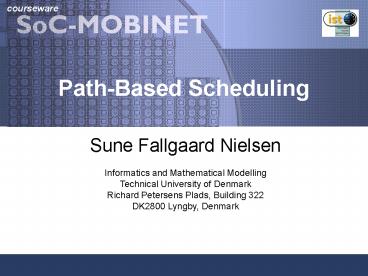Path-Based Scheduling - PowerPoint PPT Presentation
Title:
Path-Based Scheduling
Description:
Path-Based Scheduling Sune Fallgaard Nielsen Informatics and Mathematical Modelling Technical University of Denmark Richard Petersens Plads, Building 322 – PowerPoint PPT presentation
Number of Views:99
Avg rating:3.0/5.0
Title: Path-Based Scheduling
1
Path-Based Scheduling
2
Overview
- Motivation
- Introduction Prior work / new paradigm
- Defining problem and model constraints
- Solution
- AFAP Scheduling
- Algorithm
- The scheduling steps using AFAP
- Results
- Conclussion
3
Motivation
- Derive a synthesis tool which
- Minimizes the number of control steps
- Takes constraints into account
- Considers loops and conditional branches
- ( which no prior work has done )
4
Introduction
- Prior work scheduling lt- minimize cost function
- Cost function
- - Fixed hardware (uP) Number of states
- - Hardware syntheses Number of states
hardware - Scheduling
- Minimizing the cost function by moving
operations around - Optimal solution
- - Optimal schedule emphasizing concurrency
- - Force directed serialization moving mobile
operations
5
Introduction / Problem
- Path-Based Scheduling for Synthesis
- Forget cost functions!
- Instead Emphasize on conditional branches, loops
- Minimize number of control steps
- - taking constraints into account ( main
problem ) - Main problem Gain advantages from looking at
branches
6
Constraints
- Internal constraints
- Units can only receive and output values once per
cycle - With single phase clock this implies single use
per cycle - External constraints
- Amount of hardware available
- Area, units etc.
- Timing constraints
7
AFAP scheduling
- AFAP ( As Fast As Possible )
- Basic idea
- Control-flow directed graph- Nodes (ops.). Edges
(precedence relations). - Longest path Max number of operations. Cycles
only traversed once (loop unfolding) - Scheduling Put as many operations into one
control step as possible in all possible paths. - Goal Finite State Machine to implement control
8
AFAP Scheduling for a single path
- AFAP Sch. for a single path ( no loops/branches )
- Longest path is computed
- For every path constraints are computed
(variables, IOs, func. Units, max delay) and
Cuts are lain in according to constraints - Interval graph is formed with cliques (complete
subgraph of all poss. edges) - Cuts an cliques are stored for later processing
9
AFAP Scheduling for a single path
10
AFAP The algorithm
- The four steps to Nirvana ( or something )
- Transform the control flow graph into a directed
acyclic graph (DAG) - All paths in the DAG are scheduled AFAP
- Schedules are overlapped in a way to minimize the
number of control steps - The finite state machine is built.
11
AFAP Example
12
Building finite state machine
- Trivial finite state machine design
- Overlapping of intervals to form states (same cut
-gt same state) - Construct state transitions (figure out control
signals for each state) - Construct state transition conditions (rules for
looping, waiting etc)
13
Results
- Comparison is difficult since goals are
different. - Different compiler machines used
14
Conclusion Good things / bad things
- Good things
- Real life examples
- Good results
- Bad things
- No support for secondary hardware constraints
- - like busses, registers, ports etc.
- No smart loop unfolding capabilities
- No pipeline scheduling capabilities
- No instruction execution reordering supported






























